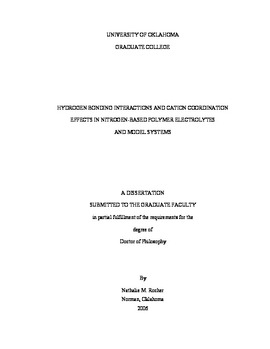| dc.contributor.advisor | Frech, Roger E., | en_US |
| dc.contributor.author | Rocher, Nathalie M. | en_US |
| dc.date.accessioned | 2013-08-16T12:20:20Z | |
| dc.date.available | 2013-08-16T12:20:20Z | |
| dc.date.issued | 2006 | en_US |
| dc.identifier.uri | https://hdl.handle.net/11244/1073 | |
| dc.description.abstract | Studies of the model-salt solutions were considerably aided by the formation of crystalline compounds whose structures were solved by single crystal x-ray diffraction methods. The frequency shifts observed in the NH stretching region were attributed to a combination of two effects: a change in the hydrogen bonding environment upon addition of salt as well as the inductive effect of the cation upon coordination to the nitrogen atom. The combination of Raman and IR experiments allowed a separation, to a certain extent, of the contribution from the two effects. This study was further aided by investigating dilution series of the electrolytes in CCl4. | en_US |
| dc.description.abstract | Results from the model compounds studies were significant, and constitute the biggest contribution to this dissertation. In all the model systems, the infrared and Raman spectra were shown to be sensitive to different populations of hydrogen-bonded molecules. In addition, spectroscopic comparisons of the pure molecules with their dilute solutions in CCl4 deepened our understanding of these systems by eliminating, to a high degree, hydrogen bonding interactions between the molecules. In DMEDA, the presence of intermolecular and intramolecular hydrogen bonding interactions complicated the analysis of the spectra. The dilution series in CCl4 significantly helped to sort out these interactions. | en_US |
| dc.description.abstract | Polymer-based solid electrolytes have been extensively studied for the past twenty five years for their use in lithium rechargeable batteries. Poly(ethylene oxide)-based materials have been so far the most widely studied systems. However, their low room temperature conductivities due to the high degree of crystallinity present in these materials have stimulated the search for alternative polymer-salt systems that are amorphous. | en_US |
| dc.description.abstract | Branched poly(ethylenimine) (BPEI) is a nitrogen based polymer with primary, secondary, and tertiary amine groups that is totally amorphous at any temperature. The understanding of hydrogen bonding interactions and ion-polymer interactions in BPEI based electrolytes has been considerably enhanced by considering three small molecules that structurally and functionally mimic parts of the polymer chain. Hexylamine (HEXA), N, N-dimethylethylenediamine (DMEDA), and dipropylamine (DPA) were used to further understand hydrogen bonding interactions and cation---nitrogen interactions in BPEI-based electrolytes. | en_US |
| dc.format.extent | ix, 175 leaves : | en_US |
| dc.subject | Cations. | en_US |
| dc.subject | Chemistry, Polymer. | en_US |
| dc.subject | Polyelectrolytes. | en_US |
| dc.subject | Hydrogen bonding. | en_US |
| dc.subject | Chemistry, Physical. | en_US |
| dc.title | Hyrdrogen [sic] bonding interactions and cation coordination effects in nitrogen-based polymer electrolytes and model systems / | en_US |
| dc.type | Thesis | en_US |
| dc.thesis.degree | Ph.D. | en_US |
| dc.thesis.degreeDiscipline | Department of Chemistry and Biochemistry | en_US |
| dc.note | Source: Dissertation Abstracts International, Volume: 67-06, Section: B, page: 3153. | en_US |
| dc.note | Adviser: Roger E. Frech. | en_US |
| ou.identifier | (UMI)AAI3222152 | en_US |
| ou.group | College of Arts and Sciences::Department of Chemistry and Biochemistry | |
